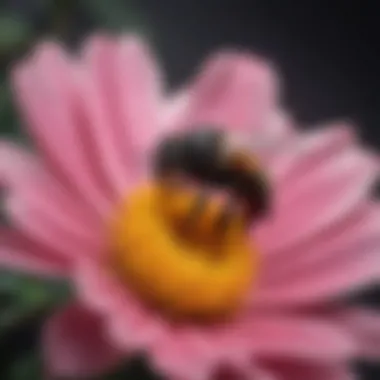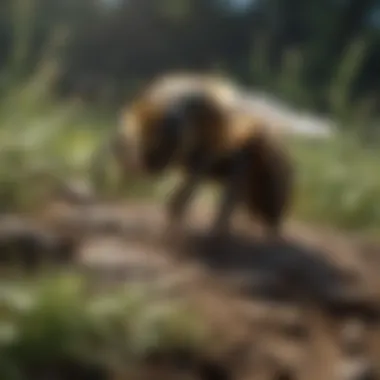Factors Influencing the Decline of Black Bees


Intro
The decline of black bee populations is not merely an environmental concern; it has far-reaching implications for agriculture, biodiversity, and ecological balance. Black bees, often overlooked in the discourse surrounding pollinators, play a crucial role in the pollination process. Unfortunately, their numbers are dwindling at an alarming rate. This article aims to dissect the many factors driving this decline. It will delve into habitat loss, pesticide exposure, disease prevalence, climate change, and other ecological pressures affecting these vital insects. By outlining these elements, the article hopes to illuminate the urgent need for conservation efforts and promote awareness among readers interested in ecological sustainability.
Key Factors
Habitat Loss
The destruction of natural habitats is one of the predominant reasons for the decline of black bees. Urban expansion, intensive agriculture, and deforestation contribute to a critical loss of environments where black bees thrive. As fields are converted into residential areas or monoculture farms, the resources needed by black bees, such as wildflowers and nesting sites, diminish. Effective land-use policies can be instrumental in mitigating this trend.
Pesticide Exposure
Pesticides, particularly neonicotinoids, have come under scrutiny for their detrimental effects on bee populations. These chemicals can disrupt the nervous systems of insects, impairing their ability to forage and reproduce. The relationship between agricultural practices and pesticide use is complex. Farmers need to balance productivity with environmental stewardship. Education about organic farming methods or integrated pest management could help reduce reliance on harmful chemicals.
Disease
Black bees are also susceptible to various diseases and parasites, which can lead to significant population declines. Pathogens such as Nosema and the Varroa mite pose substantial threats. These diseases spread rapidly in crowded and stressed populations, making healthy colony management essential. Awareness and preventive measures in beekeeping can make a difference here.
Climate Change
The effects of climate change are pervasive, affecting not only the environment but also the life cycles of black bees. Changes in temperature and precipitation patterns may alter the blooming times of flowers, causing mismatches between the availability of food sources and the life cycles of black bees. Understanding these dynamics can aid in developing adaptive strategies for conservation.
Ecological Pressures
Additional ecological pressures such as invasive species and competition with non-native bee populations can further stress black bees. The resilience of native species like the black bee must be considered when addressing biodiversity loss. Comprehensive research and monitoring programs can help track these trends and suggest corrective actions.
Epilogue
Prolusion to Black Bees
Understanding black bees is essential as their decline poses a significant threat to ecosystems and agricultural practices. This section sets the stage for examining the myriad factors contributing to their reduced populations. The black bee, recognized for its unique characteristics and role in pollination, provides various ecological benefits that merit examination.
Understanding Black Bees
Black bees, specifically the European dark bee (Apis mellifera mellifera), are a vital part of the pollinator community. These bees are distinguished by their dark coloration and robust physique. Their ability to forage for nectar and pollen from diverse plants plays a crucial role in sustaining plant biodiversity. Understanding their behavior, social structure, and life cycle is key to appreciating their ecological importance. Moreover, the decline of black bee populations can disrupt not only their species but also the numerous plants relying on them for reproduction.
Importance of Black Bees in Ecology
The significance of black bees extends beyond their immediate surroundings. They contribute to the health of ecosystems that encompass both wild and cultivated plants.
- Pollination Role: Black bees are effective pollinators. They facilitate the reproduction of various flowering plants, contributing to food production and biodiversity.
- Soil Health: Through their interactions with plants, these bees indirectly promote healthy soil ecosystems. Healthy ecosystems support not just plants but also animals that depend on them.
- Food Chain Contribution: By pollinating crops and wild plants, black bees participate in the food chain, providing nourishment for various species.
Effective pollination from black bees is essential not only for agricultural yields but also for ecological stability.
In summary, comprehending the role of black bees in ecology forms a foundation for understanding their decline. Their importance cannot be overstated, as they influence both environmental health and agricultural productivity.
Habitat Loss and Fragmentation
Habitat loss and fragmentation are critical elements contributing to the decline of black bees. This phenomenon occurs mainly due to human activities that alter the natural landscapes where these bees thrive. The destruction of habitats limits not only the food resource availability but also the nesting sites required for various bee species to reproduce and sustain their populations. Black bees, like many other pollinators, rely on a diverse range of plants for nectar and pollen, which means that habitat integrity is crucial for their survival.
Developments such as urban sprawl, logging, and infrastructure projects create fragmented ecosystems. These changes often lead to isolated habitats that cannot support large bee populations. Furthermore, fragmented habitats increase competition among bee species and other pollinators while reducing genetic diversity, making black bees more susceptible to diseases and environmental stressors.


Urbanization and Land Development
Urbanization poses a significant threat to black bee populations. As cities expand, their natural habitats are replaced by concrete and asphalt, which provide little to no sustenance for bees. The loss of flowering plants in these areas diminishes the nutrition available to black bees, leading to malnutrition and reduced reproductive success.
Additionally, urban areas often employ landscaping that favors non-native plants, which may not provide adequate resources for native pollinators. Structures and roads further limit the movement and foraging range of black bees.
According to recent studies, restoring green spaces in urban environments can help mitigate these issues. Initiatives like creating pollinator gardens and planting native flora can support not only black bees but also other beneficial insects.
Agricultural Expansion
Agricultural activities have significantly influenced black bee populations through habitat destruction. When forests and meadows are converted into farmlands, the natural habitats of black bees are lost. Monoculture practices further contribute to the decline by planting only a single crop type over extensive areas, which limits the variety of food available for bees.
The use of chemical pesticides in agriculture can also have detrimental effects. These chemicals may not only kill bees directly but can disrupt their foraging abilities and impair their reproductive systems. The large-scale cultivation of crops often leads to the removal of flowering plants that black bees depend on during specific seasons.
Efforts towards sustainable agriculture practices are essential. Techniques such as implementing crop rotation and creating buffer zones with native plants can help preserve bee habitats.
"The decline of black bees serves as a reminder that our ecosystems are interconnected and sensitive to human influences. Understanding these impacts is vital for conservation efforts."
By recognizing the pressing challenges caused by habitat loss and fragmentation, society can take necessary steps. Combating urban sprawl and promoting responsible agriculture are essential components of protecting black bees and ensuring their survival in a rapidly changing environment.
Pesticides and Chemical Exposure
Pesticides and chemical exposure play a significant role in the decline of black bee populations. These substances, designed for controlling pests, often unintentionally harm non-target species such as black bees. The risks associated with pesticide use are critical to understanding the ecological balance and health of pollinators. This section will delve into the types of pesticides that pose threats to black bees and the long-term effects that chemical exposure can have on their populations.
Types of Pesticides Affecting Black Bees
There are various types of pesticides that can affect black bees, each with distinct mechanisms of action. Some of the key categories include:
- Neonicotinoids: These are systemic insecticides that affect the central nervous system of insects. Neonicotinoids can persist in the environment, leading to long-lasting exposure for bees.
- Pyrethroids: Synthetic chemicals that mimic natural pyrethrins, pyrethroids are commonly used in both agricultural and urban settings. They can be toxic to bees upon direct contact or through residues on plants.
- Organophosphates: This group includes older pesticide formulations that inhibit enzymes essential for nerve function. Although less commonly used now, they can still be detrimental to bee populations.
Understanding these pesticides is critical for evaluating their impact on black bees, as well as developing strategies for mitigating their harm.
Long-Term Effects of Chemical Exposure
The long-term effects of chemical exposure on black bees can be severe. Continuous exposure can result in:
- Impaired Foraging Behavior: Bees exposed to high levels of pesticides may struggle to locate food sources efficiently. This leads to lower survival rates and can affect their ability to gather pollen and nectar.
- Reproductive Issues: Pesticides can disrupt hormonal systems, leading to lower reproduction rates. A decline in reproduction contributes to population reduction over time.
- Increased Susceptibility to Diseases: Chemical stressors weaken the immune systems of black bees. This increased vulnerability can result in higher mortality rates due to diseases and parasites.
"The survival of black bees hinges not only on their environment but also on the substances introduced into that environment."
Without addressing these chemical threats, conservation efforts may struggle to stabilize or reverse the decline in black bee populations. By highlighting these issues, the importance of pesticide regulations and bee-friendly practices becomes even more evident.
Diseases and Parasites
The decline of black bee populations is not just a concern for ecologists; it involves intricate biological interactions that affect agricultural stability and biodiversity. Diseases and parasites are two significant threats that compromise the health of these pollinators. Understanding how they impact black bees is crucial in addressing their population decline. In this section, we will explore common diseases that affect black bees and the effects of parasites on their populations. Both elements contribute considerably to the stress bees experience, making this topic essential in the larger context of conservation efforts.
Common Diseases Affecting Black Bees
Black bees, like all bee species, face numerous diseases that can devastate their colonies. Some of the most concerning diseases include:
- American Foulbrood: A bacterial infection that attacks bee larvae, causing severe mortality. This disease spreads through contaminated wax and larvae. Once established in a colony, it can render the entire hive ineffective.
- Nosema: This fungal infection affects the digestive systems of adult bees, leading to reduced lifespan and productivity. It can spread rapidly in crowded conditions, exacerbating other stress factors.
- Powdery Mildew: While affecting not only bees but also plants, this fungal disease compromises the bees’ foraging behaviors due to its impact on the plants they thrive on.
The presence of these diseases is often correlated with poor nutrition and habitat quality. In addition, the combined stress of disease and pesticide exposure may result in lower resilience against infections, further increasing mortality rates among black bees.


Impact of Parasites on Black Bee Populations
Parasites play a significant role in the decline of black bee populations. They not only weaken individual bees but can also disrupt whole colonies. Two main types of parasites that affect black bees are:
- Varroa Mites: These small ectoparasites attach to bees and feed on their bodily fluids, leading to weakened immune systems. Varroa mites are one of the most significant challenges in bee management, as they can also transmit viruses, which compound their detrimental effects on bee health.
- Nematodes: These microscopic roundworms can invade bee colonies and feed on larvae, potentially leading to reduced reproductive success and colony strength.
Both parasites impose additional stress on black bee populations, often leading to increased mortality rates. The fragmented habitats these bees occupy can exacerbate these impacts, making it more difficult for populations to recover.
"The health of black bees is intertwined with their environment. Diseases and parasites are not merely external threats; they compound the effects of other ecological pressures."
Addressing the issues caused by diseases and parasites requires a multifaceted approach: enhancing public awareness, increasing habitat quality, and supporting research into effective treatments are all necessary steps. By comprehensively understanding these threats, we can better support the conservation of black bee populations.
Climate Change Impacts
Climate change poses significant threats to black bee populations through shifting environmental conditions and alterations in ecosystems. These changes affect various aspects of the bees' life cycle, directly impacting their survival and role within the ecosystem. Understanding this topic is crucial as it highlights the broader implications of climate change not just on black bees, but also on agricultural productivity and ecological balance.
Temperature Variability
Temperature variability refers to the fluctuations in temperature that can occur due to climate change. For black bees, this means facing unpredictable weather patterns. Increased temperatures can lead to earlier springs, which may disrupt the synchronized relationship between blooming plants and bee activity. Pollinators like black bees rely heavily on specific flowering periods to gather food resources.
When flowering plants bloom prematurely, bees may emerge before adequate food sources are available, leading to malnutrition and reduced reproduction rates. A study indicates that changes in temperature can affect the phenology of both bees and plants, resulting in mismatches that impact pollination.
Changes in Flowering Patterns
Changes in flowering patterns are another consequence of climate change. As temperatures rise, certain plants may begin to bloom earlier or later than in previous years. This can create further challenges for black bees, as their foraging times may no longer align with the availability of nectar and pollen.
Moreover, some plant species may become less common in a given area due to their specific climate requirements, reducing food options for bees. The diversity of flora is critical for the nutritional needs of black bees, which have specific preferences for certain plants. Without adequate food supply, their health declines, and so does their population.
The interplay between changing temperatures and flowering patterns can lead to significant ecosystem disruptions, ultimately affecting agricultural yields and biodiversity.
Invasive Species
Invasive species pose a significant threat to the delicate balance of ecosystems, and their impact on black bee populations cannot be overlooked. These non-native organisms disrupt existing habitats, often outcompeting local species for resources like food and nesting sites. In the context of black bees, the effects of invasive species introduce various pressures that complicate their survival. Understanding this dynamic is crucial for developing effective conservation strategies to protect black bees and their habitats.
Competition with Non-Native Species
Black bees find themselves in a battle for survival against competitive non-native species. These invaders often thrive in diverse environments, using up nectar and pollen resources that black bees depend on for their sustenance. For instance, the introduction of species such as the honeybee can lead to resource depletion.
- Non-native plants may alter the local flora, affecting food availability.
- Aggressive foraging habits of some invasive bees can overshadow black bees, leading to food scarcity.
This competition ultimately results in reduced populations of black bees. Researchers have identified key native flowers that are vital for black bee foraging. Protecting these resources from invasive plant species is essential. Changes in land use can introduce invasive plants, further threatening black bee survival. Public awareness around this issue is necessary, as garden choices can inadvertently support invasive species.
Effects of Predation by Invasive Species
The consequences of invasive species extend beyond competition; they also include predation. Certain invasive species prey on black bees either directly or indirectly. For instance, invasive predators like ants or other predatory insects can disrupt nesting sites and lead to higher mortality rates for black bee larvae and adults.
- Predatory behavior reduces the number of black bees that reach maturity.
- The introduction of certain birds, which adapt to consuming black bees as a food source, strains their populations further.
The presence of such predators hinges on the ecological changes that result from invasive species. Their ability to thrive and spread often happens more rapidly than the local black bee populations can adapt. This issue necessitates ongoing research and monitoring to mitigate predation risks.
Understanding the role of invasive species is essential. Their presence can lead to cascading effects in ecosystems, threatening not just black bees but various native species.


Lack of Public Awareness and Engagement
The decline of black bee populations is complicated further by a general lack of public awareness and engagement. Many people do not understand the critical role that black bees play in pollination and overall ecosystem health. This lack of knowledge leads to misconceptions that can hinder effective conservation strategies. Understanding these gaps in awareness is crucial for developing a plan that encourages public involvement.
Misunderstandings about Pollination
One major issue is misunderstanding the importance of pollination itself. Many individuals view bees simply as pests or nuisances rather than key players in food production. Pollination by black bees is vital for many crops. Without them, fruits, vegetables, and flowers suffer. Many do not realize that approximately 75% of the world’s food crops depend on pollinators like black bees. By failing to recognize their ecological significance, we risk undermining efforts to protect these important species.
In addition, misconceptions about how pollination works contribute to the decline of black bees. Some individuals think that all bees perform the same role in pollination. In reality, black bees are unique in their specific pollination behaviors. They often visit a variety of flower species, making their role in sustaining diverse ecosystems irreplaceable.
"Public awareness is not simply about knowledge; it's about creating a sense of urgency in understanding the potential ecological disaster that can arise from bee population decline."
Role of Education in Conservation Efforts
Education plays a vital role in addressing the issue of lack of public awareness. When people are educated about the challenges black bees face, they are more likely to participate in conservation efforts. Educational programs should aim to inform communities about the benefits of black bees to agriculture and biodiversity.
Community engagement initiatives can serve as effective platforms for spreading awareness. Workshops, local gardening clubs, and school programs highlight the benefits of creating bee-friendly habitats. Simple actions like planting native flowers or reducing pesticide use can be encouraged through education. This can foster an environment where community members feel empowered to make choices that promote bee health.
Conservation Strategies
Conservation strategies are critical in addressing the alarming decline of black bee populations. This section underscores the necessity of implementing effective approaches to mitigate threats faced by these essential pollinators. By creating a suitable environment and advocating for supportive policies, we can foster healthier ecosystems for black bees and ultimately enhance their survival.
Creating Pollinator-Friendly Environments
Creating pollinator-friendly environments is key to reversing the decline of black bees. These environments not only provide vital resources for feeding and nesting but also offer safe havens for various species.
To cultivate a fruitful habitat, homeowners can consider the following actions:
- Plant native flora: Native plants are specifically adapted to local conditions, making them ideal sources of nectar and pollen for black bees.
- Eliminate pesticides: Reducing or eliminating harmful chemicals ensures a safer habitat for black bees. Consider using natural alternatives for pest control.
- Provide nesting sites: Creating small patches of bare soil or leaving dead wood can provide essential nesting sites for solitary bee species.
- Create diversity: A variety of plants can attract different bee species, offering more resources throughout the growing season.
"Creating a safe and diverse environment is important not only for black bees but also for the entire ecosystem."
By incorporating these practices, gardens and landscapes can transform into vital reservoirs for pollinators, enhancing biodiversity and ecosystem health.
Policy Advocacy for Bee Conservation
Policy advocacy plays a significant role in supporting conservation efforts for black bees. Effective policies can create regulations and incentives that foster environments conducive to the survival of these crucial pollinators.
Key areas where advocacy can make a difference include:
- Sustainable agricultural practices: Promoting regulations that prioritize sustainable farming techniques can reduce pesticide use and habitat destruction.
- Funding for research: Advocating for government funding directed towards studying bee populations and their needs can help develop informed conservation strategies.
- Community engagement initiatives: Supporting programs that educate communities about the importance of black bees can drive grassroots movements aimed at their protection.
- Habitat restoration projects: Encouraging policies that facilitate habitat recovery can significantly benefit both bees and the wider ecosystem.
Engagement in these policy areas is vital for instilling long-term changes that support the conservation of black bees. Together, these strategies can help ensure a healthier environment not just for black bees, but for all pollinators.
With concerted efforts and a focused approach to conservation, we can validate the importance of these strategies and contribute to the recovery of black bee populations.
The End
The decline of black bee populations encapsulates numerous interrelated issues that demand immediate attention. The intricate balance of our ecosystems relies heavily on these pollinators, which play a vital role in food production and biodiversity. As highlighted throughout this article, various factors contribute to the worrying trends in black bee numbers. From habitat loss and pesticide exposure to diseases and the ongoing impacts of climate change, each element compounds the challenges faced by these essential insects.
Recap of Key Points
- Habitat Loss and Fragmentation: Urbanization and agricultural practices continuously encroach on necessary habitats. This disrupts breeding and foraging areas, making survival increasingly difficult for black bees.
- Pesticides and Chemical Exposure: The use of harmful pesticides, including neonicotinoids, significantly affects black bee populations, leading to reduced reproductive rates and heightened mortality.
- Diseases and Parasites: Pathogens and parasites devastate black bee colonies, reducing their resilience against environmental changes. This factor is a growing concern as new diseases emerge and spread.
- Climate Change Impacts: Fluctuating temperatures and altered flowering periods impede the foraging abilities of black bees, creating a mismatch in food availability when they need it most.
- Invasive Species: Non-native plants and pollinators can outcompete black bees for resources, leading to declining populations and altered ecosystems.
- Lack of Public Awareness: Often, misconceptions surrounding black bees impede conservation efforts. Enhancing public education is crucial for fostering engagement in these conservation initiatives.
Call to Action for Readers
As concerned individuals, now is the time to make a visible impact. Engage in local conservation efforts and support policies aimed at protecting pollinator habitats. Here are actionable steps to consider:
- Plant Native Flowers: Cultivate gardens with native plants to provide food sources for black bees.
- Advocate for Sustainable Practices: Support local farmers who utilize organic farming methods that do not rely on harmful pesticides.
- Educate Others: Share knowledge about black bees within your community. The more awareness created, the better chance there is for effective conservation initiatives.
- Participate in Citizen Science: Engage in local studies or surveys aimed at monitoring bee populations. Resources like reddit.com and facebook.com offer platforms for community connection.







